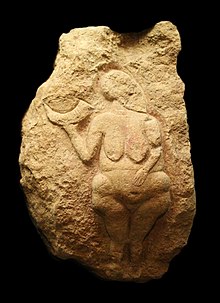Laussel
Coordinates: 44 ° 56 '50 " N , 1 ° 6' 25" O Laussel is a Upper Paleolithic site in the French community of Marquay in the Dordogne department . It isbest knownthrough the discovery of Venus von Laussel and is part of the Franco-Cantabrian cave art .
location

The Laussel site, named after the Laussel castle from the 15th and 16th centuries , is located on the right bank of the Grande Beune , a left tributary of the Vézère , about 200 meters above the castle and 2 kilometers west of Marquay. It consists of three abrises , the approximately 100 meters long and 10 meters high Grand Abri , a smaller abri up the valley and the Abri du Four downstream. The abrises are located directly below the D 48.
history
The three abrises, particularly the Grand Abri, were first explored by Rivière in 1896. The doctor G. Lalanne , a lover of archeology , had excavations carried out between 1908 and 1914. In the course of the work, five reliefs were discovered in the layers of the Solutréen between 1911 and 1912 , including the famous Venus von Laussel , also known as Vénus à la corne . This work of art, executed as a relief, was on a boulder several cubic meters in size that had broken out of the roof of the demolition. The other relief work was carried out in 40 to 50 centimeters large, transportable limestone slabs , which, strangely enough, were all found in the immediate vicinity of the stone block with Venus. This place was consequently called a kind of cella , i.e. H. interpreted as a primitive sanctuary.
Stratigraphy and Age
The approximately 5 meter thick sediment filling in the Grand Abri, which formed in the limestone of the Coniacian , is one of the most important sedimentary sequences of the Middle Paleolithic and the Upper Paleolithic . Its 11 layers range from the early Moustérien to the Solutréen , i.e. H. the sequence covers the period 100,000 to 17,000 years BP . In between there are Typical Moustérien (around 70,000 years BP), Châtelperronien (around 35,000 years BP) and Lower Périgordien , Aurignacien (around 30,000 years BP), Gravettia , Upper Périgordien and two layers of Solutréen (older and more recent Solutréen, 25,000 to 17,000 years old BP).
Finds
Several boulders with engravings from the Aurignacien have been discovered, but the famous reliefs are all from the Solutréen.
In addition to the Venus von Laussel , the following reliefs were found:
- a male figure in a hunter pose. This classic interpretation is controversial, it could just as easily be a young female person.
- a so-called Venus of Berlin ( French Vénus de Berlin ). This figure was sold to the Ethnological Museum in Berlin-Dahlem and was lost during the Second World War.
- a Venus with a checkered head (French: Vénus à la tête quadrillée ).
- two people in head-to-foot position, one of whom is certainly female. A delivery may have been presented.
The works of art were accompanied by various artifacts from different locations.
swell
- Delluc, B. & G., Roussot, A. & Roussot-Larroque, J .: Connaître la préhistoire en Périgord . Éditions SUD-OUEST, 1990, ISBN 2-87901-048-9 .
